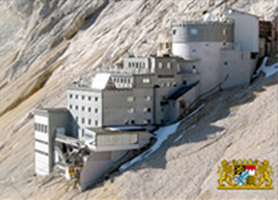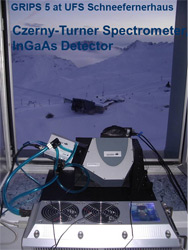ARISE technologies
Airglow observations

Germany and CONICET, Argentina

(Ground-based Infrared P-branch Spetrometer),
instrument
The observation of airglow and the derivation of temperatures in the mesopause altitude region was initiated 6 decades ago by the work of Meinel.Airglow observations have since then been performed by research groups all over the world using ground-based, rocket-based and satellite-based spectrometers.
The airglow is electromagnetic radiation emitted in the upper mesosphere in the visible and near infrared due to atomic and molecular excitations at these heights. The origin of most airglow-luminescence is a rather narrow layer of excited hydroxyl (OH) molecules from about 83-90 km height peaking around about 87 km. The excitation is caused by the exothermic reaction of ozone and atomic hydrogen. The other prominent airglow source is the layer of molecular oxygen (O2) emitting at a peak altitude at about 95 km. Other contributors to the airglow are the layers of sodium, of iron (Fe), of potassium (K) and calcium (Ca). The observation of airglow features by spectroscopic methods is a widely used method for the determination of upper mesospheric parameters, especially rotational temperatures and airglow intensities.
First world-wide coordinated cooperation of the different global-distributed airglow observation sites under the umbrella of a global measurement network – NDMC – were achieved following a founding initiative of the German Remote Sensing Data Center of the German Aerospace Center (DLR-DFD) in 2006. Network operations of the NDMC have officially started in 2007 and are jointly coordinated by the DLR-DFD and the Argentinean organization CONICET accompanied by an international management team with representatives of the airglow community from Argentina, Australia, Germany, Norway and USA. Coordination centre is the Environmental Research Station Schneefernerhaus (UFS) on the mountain Zugspitze in Germany. NDMC is affiliated with the Global Atmosphere Watch (GAW) program of the World Meteorological Organization (WMO) and with the Network for the Detection of Atmospheric Composition Change (NDACC).

NDMC has an interdisciplinary emphasis, with active inclusion of social relevant issues. It links researchers across different fields to address questions and issues lying beyond the scope of individual disciplines and strengthens international coordination of research and enhances international collaboration and cooperation. NDMC is currently composed of 49 high-quality, remote-sensing research stations for observing and understanding the physical and chemical state of the mesosphere with initial emphasis on the mesopause . NDMC also focuses on assessing the impact of mesospheric changes on the troposphere and stratosphere and vice versa and on global climate.
NDMC ’s research objectives include the investigation of solar activity and climate change, coupling processes and atmospheric dynamics (i.e. waves on all scales), the development of instrumentation as well as intercomparison and validation. Most if not all of these thematic areas are also relevant for the international collaboration and cooperation with other networks especially within this study. The combined research will significantly improve the understanding of middle atmosphere dynamics as well as weather and climate processes.

 ARISE Home
ARISE Home ARISE Data Center
ARISE Data Center